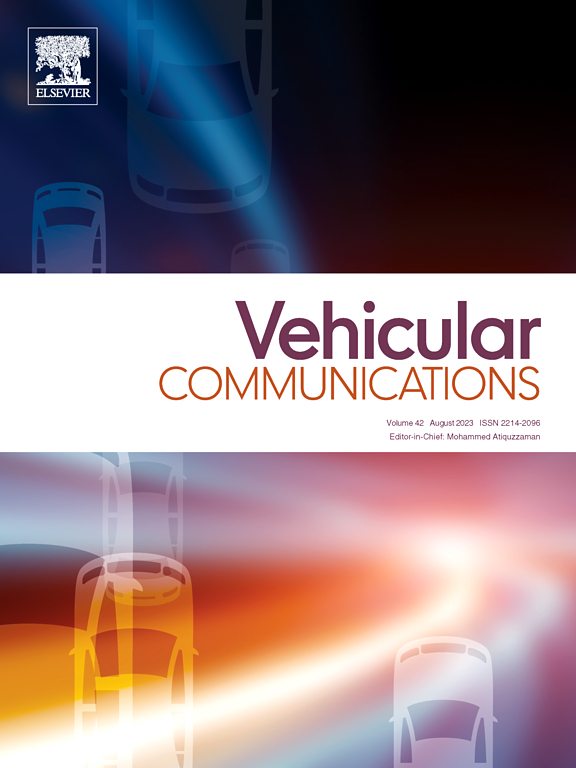An adaptive bendable virtual tunnel routing protocol for flying ad-hoc networks
IF 6.5
2区 计算机科学
Q1 TELECOMMUNICATIONS
引用次数: 0
Abstract
Flying ad-hoc networks (FANETs) play a crucial role in disaster response, surveillance, and remote sensing. However, their highly dynamic topology and frequent link disruptions pose significant challenges to efficient routing. Existing protocols suffer from excessive control overhead, unstable links, and inefficient energy utilization, that limits their practical deployment. To address these issues, we propose an adaptive bendable virtual tunnel routing protocol (ABVTR), which constructs a three-dimensional (3D) adaptive bendable virtual relay tunnel (3D-ABVRT) using Bézier curves. This tunnel restricts the propagation of route request messages, reducing redundant transmissions, and enhancing routing stability, particularly in sparsely connected UAV networks. ABVTR employs a piecewise function to align UAV movement with the tunnel's centerline, effectively minimizing deviations and reducing delays. Furthermore, it dynamically determines the next-hop node by considering movement direction, relative speed, and residual energy. The latter two factors are assessed using a S-function and an exponential function, respectively, to enhance link reliability and optimize energy distribution. This work advances the state-of-the-art by introducing a more adaptive, energy-efficient, and scalable routing solution for FANETs. The simulation results show that ABVTR significantly outperforms existing protocols (EARVRT, iPipe, HMGOC, CF-GPSR, FM-DT-GDR) in end-to-end delay, packet delivery ratio (PDR), and routing overhead. These enhancements position ABVTR as a highly promising solution for mission-critical FANETs application, enabling more resilient, scalable, and efficient aerial networks.
一种用于飞行自组织网络的自适应弯曲虚拟隧道路由协议
飞行自组织网络(fanet)在灾害响应、监视和遥感方面发挥着至关重要的作用。然而,它们的高动态拓扑结构和频繁的链路中断对高效路由提出了重大挑战。现有协议存在控制开销过大、链路不稳定、能量利用率低等问题,限制了其实际部署。为了解决这些问题,我们提出了一种自适应可弯曲虚拟隧道路由协议(ABVTR),该协议利用bsamizier曲线构建了一个三维(3D)自适应可弯曲虚拟中继隧道(3D- abvrt)。该隧道限制了路由请求消息的传播,减少了冗余传输,增强了路由的稳定性,特别是在稀疏连接的无人机网络中。ABVTR采用分段功能将无人机运动与隧道中心线对齐,有效地减少偏差并减少延迟。通过考虑运动方向、相对速度和剩余能量,动态确定下一跳节点。后两个因素分别使用s函数和指数函数进行评估,以提高链路可靠性和优化能量分配。这项工作通过为fanet引入更具适应性、节能和可扩展的路由解决方案,推进了最先进的技术。仿真结果表明,ABVTR协议在端到端时延、包分发率(PDR)和路由开销等方面明显优于现有协议EARVRT、iPipe、HMGOC、CF-GPSR、FM-DT-GDR。这些增强使ABVTR成为关键任务fanet应用的一个非常有前途的解决方案,实现更有弹性、可扩展和高效的空中网络。
本文章由计算机程序翻译,如有差异,请以英文原文为准。
求助全文
约1分钟内获得全文
求助全文
来源期刊

Vehicular Communications
Engineering-Electrical and Electronic Engineering
CiteScore
12.70
自引率
10.40%
发文量
88
审稿时长
62 days
期刊介绍:
Vehicular communications is a growing area of communications between vehicles and including roadside communication infrastructure. Advances in wireless communications are making possible sharing of information through real time communications between vehicles and infrastructure. This has led to applications to increase safety of vehicles and communication between passengers and the Internet. Standardization efforts on vehicular communication are also underway to make vehicular transportation safer, greener and easier.
The aim of the journal is to publish high quality peer–reviewed papers in the area of vehicular communications. The scope encompasses all types of communications involving vehicles, including vehicle–to–vehicle and vehicle–to–infrastructure. The scope includes (but not limited to) the following topics related to vehicular communications:
Vehicle to vehicle and vehicle to infrastructure communications
Channel modelling, modulating and coding
Congestion Control and scalability issues
Protocol design, testing and verification
Routing in vehicular networks
Security issues and countermeasures
Deployment and field testing
Reducing energy consumption and enhancing safety of vehicles
Wireless in–car networks
Data collection and dissemination methods
Mobility and handover issues
Safety and driver assistance applications
UAV
Underwater communications
Autonomous cooperative driving
Social networks
Internet of vehicles
Standardization of protocols.
 求助内容:
求助内容: 应助结果提醒方式:
应助结果提醒方式:


